So you are a disciplined runner, quite happy with your choice of workout. The joy of trying to catch your breath after a good run with sweat dripping from the forehead, when the mind is totally in the present moment, is quite a spiritual experience for many. So why Yoga when you run? The idea of No Pain No Gain has been drilled into our heads since childhood. But here’s how Yoga can help you run better, faster and with much less pain.
It is common for runners to complain about injuries in the hip or limbs. This could be due to cramps, poor stretching or not enough warm up. To stay away from injuries as a runner, just stretching is not enough. You need to learn and practice Yoga to know about the postures that will make your body more flexible, less prone to injuries, more alert and give your workout experience more depth. Simply put, yoga compliments and amplifies the benefits of running for you. And what do you know? Next time, you may find yourself covering more distance with much ease!
Some asanas that runners can practice include
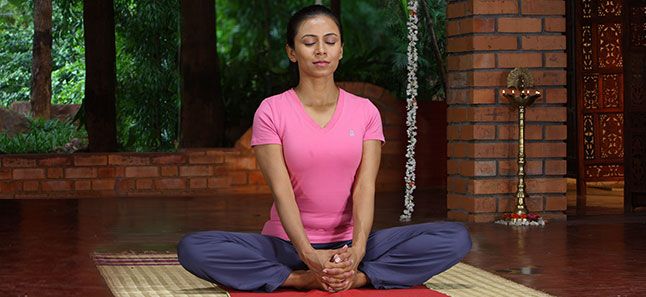
www.artofliving.org
1. Butterfly pose (Badhakonasana)
Sit in Sukhasana with legs crossed comfortably. Now for Butterfly pose,
- Make a Namaste with both the feet and come in butterfly pose. Once in this pose,
- Swing the knees like a butterfly. Take 2 deep breaths.
- As we breathe in, catch the toes, look up and slowly bend forward.
- Stay in this posture for 2-3 deep breaths.
- Slowly come up and relax.
2. Seated Half Spinal Twist (Ardha Matsyendrasana)
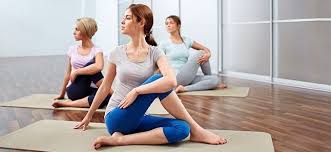
For this asana,
- Bend the right knee,
- place the right foot next to the left hip,
- bend the left knee,
- place the left foot next to the right side of the right thigh,
- the left hand is on the right knee and the right hand behind you.
- Now, twist the waist, shoulders and neck in that order to the right and look over the right shoulder.
- Take a few deep breaths and feel the twist. Come back to the center and switch sides.
3. Standing Forward Bend or Hasta Padasana
In this asana,
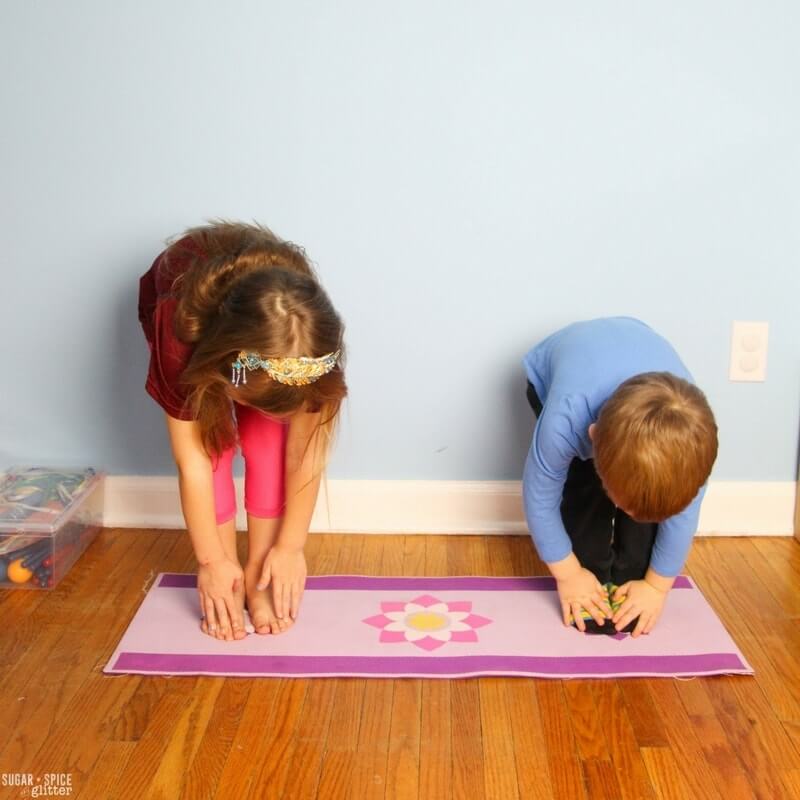
As we breathe out, we try and lower our upper body to bring the knees closer to the chest region. We don’t over exert ourselves in this posture. We do only as much as we can comfortably do without a quivering breath.
We stay in this pose for 2-3 rounds of breaths and then slowly come up in Tadasana or palm tree pose.
4. Trikonasana or Triangle Pose

- Spread out both the legs about 3 feet apart
- Place the right ankle 90 degrees outside and the left ankle is straight in the front.
- Pelvis and chest are facing front side too.
- As you breathe in, take both the hands up by the sides parallel to the floor in alignment with the shoulders
- and then slowly bend to the right side.
- Try to touch your right ankle with your right hand and
- left hand is 90 degrees from the floor up in the air.
- Twist your neck to the left side and look at your left hand.
- Stay in this posture for 5-10 long deep breaths.
- Slowly come up as you breathe in and relax your hands.
- Now twist the left ankle outside and repeat
5.Vrikshasana or Tree Pose
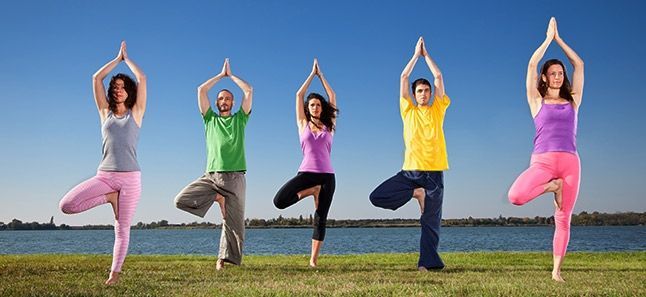
- Fix your eye gaze at one point which is not shaky.
- Then, lift your right leg with the support of your hand and then
- Place the right feet on the left inner thigh.
- As you breathe in, take both your hands up and make Namaste with both the hands.
- Stay in this posture for 5-6 long breaths. And then slowly relax.
- Repeat the asana with the left leg.
6. Warrior pose (Virabhadrasana)
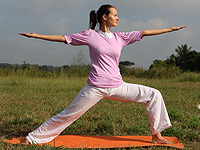
This is ideal pose for letting go of the stress in your shoulders and arms. It helps build body balance and stamina while toning the arms, legs and the lower back.
- Stand with your legs apart by about 3 feet.
- The right foot is out 90 degrees and the left foot is in 15 degrees. Make sure the right heel is aligned with the inner center of the left foot.
- Both the arms are up to the shoulder level parallel to the ground with palms facing the sky.
- As you breathe out, bend the right knee in a way that the right knee and ankle are as straight as possible. The knee does not overshoot the ankle.
- The head is turned to the right. Look right.
- You can stretch into this pose some more while breathing deeply. You can push the pelvis downwards. Make sure you do as much as your body permits. Do not overstretch.
- As you breathe in, come up and as you breathe out bring the hands down.
- Repeat it on the left leg.
Do not do this pose if you have spine injuries or high blood pressure. If you have a knee issue, you can use the support of a wall.
8. Upward Plank Pose (Purvottanasana)
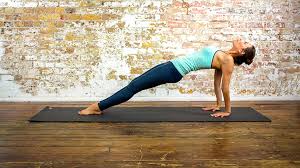
Lie on your back.
- For Purvottanasana, as you breathe in, lift your body up on your palms then on the toes.
- And slowly as you breathe out, come down and as you breathe in, hands by the side. Repeat this cycle 5 times.
9. Chair pose or Utkatasana
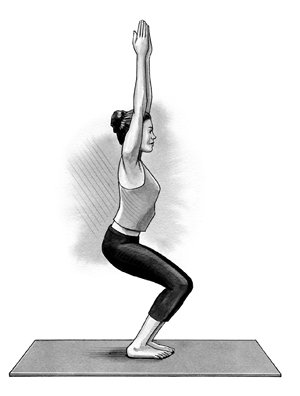
- Lift both the hands up from the front and arrive at a 45-degree angle midway between parallel to the floor and straight over your head.
- Slowly as you breathe out, bend your knees and your body will descend, push your hips all the way back, keep the entire spinal cord straight.
- Your hands are up, biceps touching the ears. Look in front and stay there for 5-7 long breaths.
10. Oil Massage
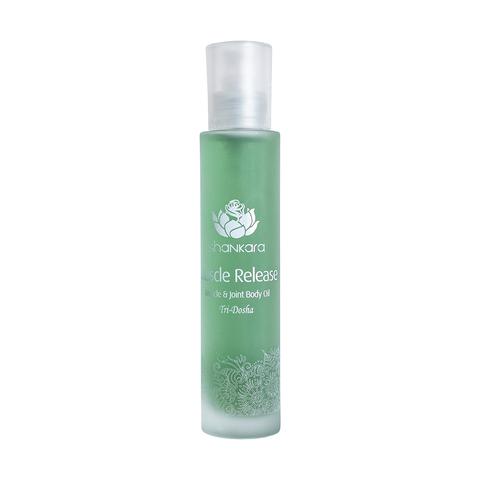 Shankara's Muscle Release Oil
Shankara's Muscle Release Oil
Once you finish with your Yoga session or for that matter any other work out, it is a good idea to give yourself a full body massage using herbal muscle release oil that seeps into your muscular tissues, lubricating and rejuvenating each muscle fiber in your body. It also releases the psychosomatic stress stored in your body. For example, the Shankara Muscle Release Oil, a unique blend of eastern herbal essences and actives from the west like sunflower, almond, sesame, aloe vera, castor, jojoba, sweet birch, lavender, cedarwood, frankincense, devils claw, boswellia among others, is widely being used by those who are into sports, Yoga or some form of workout that works up the muscle tissues of the body.
It is important to learn and practice yoga postures under the supervision of a trained Sri Sri Yoga teacher.

 www.artofliving.org
www.artofliving.org







 Shankara's Muscle Release Oil
Shankara's Muscle Release Oil











